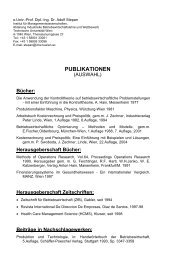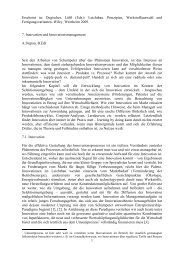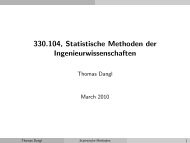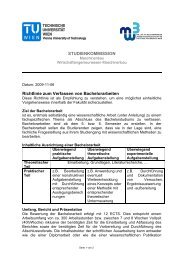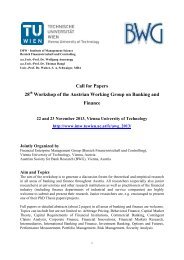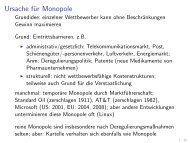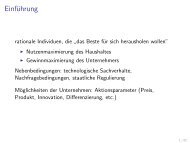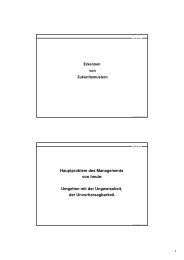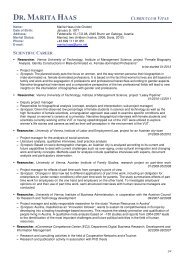Advanced Topics in Corporate Finance - IMW
Advanced Topics in Corporate Finance - IMW
Advanced Topics in Corporate Finance - IMW
You also want an ePaper? Increase the reach of your titles
YUMPU automatically turns print PDFs into web optimized ePapers that Google loves.
<strong>Advanced</strong> <strong>Topics</strong> <strong>in</strong> <strong>Corporate</strong> F<strong>in</strong>anceThomas DanglTU Wienthomas.dangl@tuwien.ac.athttp://www.imw.tuwien.ac.at/danglVGSF, 2010Cont<strong>in</strong>uous-Time F<strong>in</strong>ance Toolbox
The Market Price of Risk (1)• Assume the dynamics of a s<strong>in</strong>gle underly<strong>in</strong>g process X(t) [which is notnecessarily traded] asdX(t) = µ(t, X(t))dt + σ(t, X(t))dW (t)X(0) = X 0where dW (t) is the <strong>in</strong>crement to a Wiener process W (t). This is a Markovprocess.• The value of X will characterize the state of the firm (level of current cashflows,value of the unlevered productive assets, etc.)Cont<strong>in</strong>uous-Time F<strong>in</strong>ance Toolbox 1
The Market Price of Risk (2)• There exists a money account B(t) with the dynamicsdB(t) = r(t)B(t)dt,B(0) = B 0 .We assume <strong>in</strong> what follows r(t) = r = constant. Many of the results, however,hold <strong>in</strong> the general case of stochastic <strong>in</strong>terest rates.• Assume further that there exists a claim F = F (t, X(t)) cont<strong>in</strong>gent on theprocess X, where F denotes the market value of the claim.• It is assumed that F is twice differentiable <strong>in</strong> X and once <strong>in</strong> t.Cont<strong>in</strong>uous-Time F<strong>in</strong>ance Toolbox 2
The Market Price of Risk (3)• Then Itô’s Lemma gives the dynamics of F asdF = ∂F∂tF (0) = F 0 .dt +∂F∂X dX + 1 2 ∗ ∂2 F∂X 2σ2 dt,• Please note: This is NOT a valuation equation. If X(t) is NON-traded, thereis NO WAY to derive a unique market price of the claim F from the knowledgeof X and its dynamics.Cont<strong>in</strong>uous-Time F<strong>in</strong>ance Toolbox 3
The Market Price of Risk (4)• If there is more than one claim traded on a well-function<strong>in</strong>g market, i.e.F i (t, X(t)) cont<strong>in</strong>gent on the realizations of X, the F s can be priced relativeto one reference claim (under some regularity conditions).• From Itô’s Lemma we know:dF i ={ ∂Fi∂t + ∂F i∂X µ(t, X(t)) + 1 }2 σ2 (t, X(t)) ∂2 F i∂X 2dt + ∂F iσ(t, X(t))dW.∂XCont<strong>in</strong>uous-Time F<strong>in</strong>ance Toolbox 4
The Market Price of Risk (5)• In many cases, hold<strong>in</strong>g a claim is associated with the right to receive certa<strong>in</strong>payoffs.• Let D i (t) denote the accumulated payouts associated with hold<strong>in</strong>g claim F ifrom time 0 to time t.If δ i (t, X(t)) is the flow (aga<strong>in</strong> cont<strong>in</strong>gent on X), then we haveD i (t) =∫ t0δ i (τ, x(τ))dτ,or the flow differentialdD i (t) = δ i (t, X(t))dt.Cont<strong>in</strong>uous-Time F<strong>in</strong>ance Toolbox 5
The Market Price of Risk (6)• Then the ga<strong>in</strong> differential dG i can be def<strong>in</strong>ed asdG i = dF i + dD i ,where dF i is the capital ga<strong>in</strong> differential and dD i is the payout differential.dG i ={ ∂Fi∂t + ∂F i∂X µ(t, X(t)) + 1 }2 σ2 (t, X(t)) ∂2 F i∂X 2 + δ i(t, X(t)) dt+ ∂F iσ(t, X(t))dW (t).∂XCont<strong>in</strong>uous-Time F<strong>in</strong>ance Toolbox 6
The Market Price of Risk (7)• Write the relative ga<strong>in</strong> differential asdG iF i= α i (t, X(t))dt + σ i (t, X(t))dWwhereα i = 1 F i{ ∂Fi∂t + ∂F i∂X µ + 1 2 σ2∂2 F i∂X 2 + δ }σ i = 1 F i{ ∂Fi∂X σ }(arguments (t, X(t)) are dropped for brevity)Cont<strong>in</strong>uous-Time F<strong>in</strong>ance Toolbox 7
The Market Price of Risk (8)• Let us take two different claims, F i and F j , and form an <strong>in</strong>stantaneouslyriskless portfolio:V = h i F i + h j F j• Def<strong>in</strong>e the relative portfolio weights:u i = h iF iV , u j = h jF jV⇒ h i = u iVF i,h j = u jVF jCont<strong>in</strong>uous-Time F<strong>in</strong>ance Toolbox 8
The Market Price of Risk (9)• For valuation, the total ga<strong>in</strong> differential must be considereddV = h i dG i + h j dG j{}dG i dG j= V u i + u jF i F j= V {u i α i + u j α j } dt + V {u i σ i + u j σ j } dW• Then form a riskless ga<strong>in</strong> portfoliou i + u j = 1u i σ i + u j σ j = 0Cont<strong>in</strong>uous-Time F<strong>in</strong>ance Toolbox 9
The Market Price of Risk (10)• This leads to portfolio weightsu i =u j =−σ jσ i − σ jσ iσ i − σ jThis only makes sense if σ i ≠ σ j !• The ga<strong>in</strong> dynamics of this portfolio are thendV = V{ }αj σ i − α i σ jdt + 0dWσ i − σ jCont<strong>in</strong>uous-Time F<strong>in</strong>ance Toolbox 10
The Market Price of Risk (11)• S<strong>in</strong>ce this portfolio is <strong>in</strong>stantaneously riskless, absence of arbitrage impliesdV = r(t)dt⇒ α jσ i − α i σ jσ i − σ j= r(t),α j σ i − α i σ j = r(σ i − σ j ),(α j − r)σ i − (α i − r)σ j = 0,α j − r− α i − rσ j σ i= 0,⇒ α i − r(t)σ iwhere λ(t) is the market price of risk.= α j − r(t)σ j= λ(t), ∀i, j,Cont<strong>in</strong>uous-Time F<strong>in</strong>ance Toolbox 11
Valuation (1)• Now we substitute for α i , σ i :write the no-arbitrage condition as α i − r = λ(t)σ i :1F i{ ∂Fi∂t + ∂F i∂X µ i(t, X(t))+ 1 2 σ i(t, X(t)) ∂2 F i∂X 2 + δ(t, X(t)) }− r = 1 F iσ i (t, X(t))λ(t) ∂F i∂Xr(t)F i = ∂F i∂t + ∂F i∂X {µ i(t, X(t)) − λ(t)σ i (t, X(t))}+ 1 ∂ 2 F i2 ∂X 2σ2 (t, X(t)) + δ(t, X(t))F i (T, x) = φ(x)• Note: T can be an adapted random stopp<strong>in</strong>g time.Cont<strong>in</strong>uous-Time F<strong>in</strong>ance Toolbox 12
Valuation, Special Cases (1)• Let us regard two special cases for the dynamics of X(t)◦ Brownian motiondX = µ dt + σ dW (µ, σ = constant),X(0) = X 0 .◦ Geometric Brownian motiondXX= µ dt + σ dW (µ, σ = constant)Cont<strong>in</strong>uous-Time F<strong>in</strong>ance Toolbox 13
Valuation, Special Cases (2)• Correspondence between Brownian motion and Geometric Brownian motion:Suppose X(t) with dynamicsdX = µ dt + σ dW,X(0) = X 0 .⇒ X(t) = X 0 += X 0 +∫ t0∫ t0dX,µ dt +∫ t0= X 0 + µt + σW (t).σ dW,Cont<strong>in</strong>uous-Time F<strong>in</strong>ance Toolbox 14
Valuation, Special Cases (3)• Def<strong>in</strong>ey(t) = exp{X(t) − 1 2 σ2 t}.⇒ dy = yµ dt + yσ dW,y 0 = e X 0i.e. y(t) is a Geometric Brownian motion, and E[y(t)] = y 0 e µt .• Note:E[y] = E[ {y 0 exp (µ − 1 }]2 σ2 )t + σW (t)We know that W (t) is normally distributed with mean 0 and variance t. Thus,we can <strong>in</strong>tegrate the density weighted value of y over the range (−∞, ∞) toget the above statement.Cont<strong>in</strong>uous-Time F<strong>in</strong>ance Toolbox 15
Valuation, Special Cases (4)• Valuation Equationr(t)F = ∂F∂t + ∂F∂X {µ − λ(t)σ} + 1 2∂ 2 F∂X 2σ2 + δ(t, X(t)).• Note:◦ λ(t), r(t) can be any processes adapted to the <strong>in</strong>formation set F t⇒ may be path dependent,⇒ solution complicated and F ≠ F (X(t), t) but F = F (t, {X(τ)|0 ≤ τ ≤t}).◦ special functional form of δ(t, X(t)) might also cause problems when solv<strong>in</strong>gthe equation (see Feynman-Kač below).Cont<strong>in</strong>uous-Time F<strong>in</strong>ance Toolbox 16
Valuation, Special Cases (5)• Remember• Valuation equationdXX= µ dt + σ dW (µ, σ = constant)r(t)F = ∂F∂t + ∂F∂X X{µ − λ(t)σ} + 1 2∂ 2 F∂X 2X2 σ 2 + δ(t, X(t))Cont<strong>in</strong>uous-Time F<strong>in</strong>ance Toolbox 17
Valuation, Special Cases (6)• Assume X(t) is itself a traded security, pay<strong>in</strong>g δ(t, X(t)) per time <strong>in</strong>terval tothe security trader.◦ We know that◦ Then∂X∂t = 0,∂X∂X = 1,∂ 2 X∂X 2 = 0.α x = 1 {µ(t, X(t)) + δ(t, X(t))},Xσ x = 1 {σ(t, X(t))}.XCont<strong>in</strong>uous-Time F<strong>in</strong>ance Toolbox 18
Valuation, Special Cases (7)• no arbitrage → X must satisfyα X − rσ X= λ(t).You can also <strong>in</strong>terpret this equation as: the dynamics of the traded asset Xdef<strong>in</strong>e or reveal λ(t).• Now1X {µ(t, X(t)) + δ(t, X(t))} − r(t) = λ(t) 1 σ(t, X(t)),X⇒ r X = µ(t, X(t)) + δ(t, X(t)) − λ(t)σ(t, X(t)).Cont<strong>in</strong>uous-Time F<strong>in</strong>ance Toolbox 19
Valuation, Special Cases (8)• If X is a Geometric Brownian motion:• Next step:r = µ + δ(t)X − λ(t)σµ − λ(t)σ = r(t) − δ(t)X◦ Assume λ is constant, i.e. λ(t) = λ.◦ Assume r is constant, i.e. r(t) = r.• ⇒ if µ and σ are constant, µ − λσ = ˆµ is constant.ˆµ is the risk-neutral drift of the underly<strong>in</strong>g.• Now we consider some special setups <strong>in</strong> order to derive different modules thathelp us to determ<strong>in</strong>e general solutions of the valuation equation.Cont<strong>in</strong>uous-Time F<strong>in</strong>ance Toolbox 20
Valuation, Solv<strong>in</strong>g the HJB-Equation (1)• Suppose F (x) is a claim that pays K whenever the process X first hits a lowerbarrier x < X 0 , i.e. δ(t, X(t)) = 0.Let X follow a simple Brownian motion. Then the valuation equation is:rF = ∂F∂t + ∂F∂x ˆµ + 1 ∂ 2 F2 ∂x 2 σ2 .• S<strong>in</strong>ce F is not explicitly time dependent,∂F∂t= 0,⇒ rF = ∂F∂x ˆµ + 1 2∂ 2 F∂x 2 σ2 .This is an ord<strong>in</strong>ary second order differential equation which is homogenous <strong>in</strong>the derivatives of F .Cont<strong>in</strong>uous-Time F<strong>in</strong>ance Toolbox 21
Valuation, Solv<strong>in</strong>g the HJB-Equation (2)• Solution approach: Assume (ansatz)F = e βx ,⇒ ∂F∂x = βeβx ,∂ 2 F∂x 2 = β2 e βx .• Substitute <strong>in</strong>to drift equation:re βx = βe βxˆµ + 1 2 β2 e βx σ 2 , ⇒ r − β ˆµ − 1 2 β2 σ 2} {{ }fundamental quadratic= 0.• The solutions are:β 1,2 = − ˆµ σ 2 ± √ ( ˆµσ 2 ) 2+ 2 r σ 2} {{ }> ˆµ σ 2 if r>0Cont<strong>in</strong>uous-Time F<strong>in</strong>ance Toolbox 22
Valuation, Solv<strong>in</strong>g the HJB-Equation (3)• S<strong>in</strong>ce we know that r > 0 ⇒, β 1 > 0 and β 2 < 0.rΒCont<strong>in</strong>uous-Time F<strong>in</strong>ance Toolbox 23
Valuation, Solv<strong>in</strong>g the HJB-Equation (4)• The general solution is thenF (x) = Ae β 1x + Be β 2x• Needs two boundary conditions.• Assume a claim F pays K when x hits a lower barrier x:(i) lim x→x+ F (x) = K,(ii) lim x→∞ F (x) = 0.• The transversality condition (ii) is often called the ”exclusion of speculativebubbles”.Cont<strong>in</strong>uous-Time F<strong>in</strong>ance Toolbox 24
Valuation, Solv<strong>in</strong>g the HJB-Equation (5)• From (ii) it follows A = 0 s<strong>in</strong>ce β 1 > 0.• Condition (i) impliesF (x) = Be β 2x⇒⇒ F (x) = e β 2(x−x)} {{ } KD(x)B = Ke −β 2x• D(x) is a discount factor. S<strong>in</strong>ce β 2 < 0,⇒ D(x) ↓ 0 for x ↑ ∞,⇒ D(x) ↑ 1 for x ↓ x.Cont<strong>in</strong>uous-Time F<strong>in</strong>ance Toolbox 25
Valuation, Solv<strong>in</strong>g the HJB-Equation (6)• Assume a claim that pays K when X hits an upper barrier ¯x.• The general solution is the same as above but boundary conditions change.(i) lim x→x− F (x) = K(ii) lim x→−∞ F (x) = 0• From (ii) it follows that B = 0 s<strong>in</strong>ce β 2 < 0.• Condition (i) impliesF (¯x) = Ae β 1¯x⇒ A = Ke −β 1¯x .F (x) =e −β 1(¯x−x)} {{ } Kdiscount factorCont<strong>in</strong>uous-Time F<strong>in</strong>ance Toolbox 26
Valuation, Solv<strong>in</strong>g the HJB-Equation (7)• Now suppose that X follows a Geometric Brownian motion, F is a claim thatpays K if X hits a lower threshold x, aga<strong>in</strong> ∂F∂t= 0, F = F (x).• Valuation EquationrF = ∂F∂x xˆµ + 1 ∂ 2 F2 ∂x 2 x2 σ 2• Solution approach (ansatz)F (x) = x β⇒ ∂F∂x = βxβ−1∂ 2 F∂x 2 = β(β − 1)x β−2Cont<strong>in</strong>uous-Time F<strong>in</strong>ance Toolbox 27
Valuation, Solv<strong>in</strong>g the HJB-Equation (8)• Substitution <strong>in</strong>to the valuation equation yieldsrx β = β ˆµ xx β−1} {{ }x β+ 1 2 β(β − 1)σ2 x 2 x β−2} {{ }x β• Get the fundamental quadraticr − β ˆµ − 1 2 β(β − 1)σ2 = 0• Aga<strong>in</strong> we have β 1 > 0, β 2 < 0.Cont<strong>in</strong>uous-Time F<strong>in</strong>ance Toolbox 28
Valuation, Solv<strong>in</strong>g the HJB-Equation (9)• Roots of the fundamental quadratic:β 1,2 = 1 2 − ˆµ σ 2 ± √ (12 − ˆµ σ 2 ) 2+ 2rσ 2Cont<strong>in</strong>uous-Time F<strong>in</strong>ance Toolbox 29
Valuation, Solv<strong>in</strong>g the HJB-Equation (10)• If r > ˆµ, we have furthermore β 1 > 1:β 1 = 1 2 − ˆµ σ 2 + √ √√√√ ( 12 − ˆµ σ 2 ) 2+ 2rσ 2} {{ }∗∗ = 1 4 − ˆµ σ 2 + ( ˆµσ 2 ) 2+ 2rσ 2 > 1 4 − ˆµ σ 2 + ( ˆµσ 2 ) 2+ 2ˆµσ 2 = ( 12 + ˆµ σ 2 ) 2⇒ β 1 > 1 2 − ˆµ σ 2 + √ (12 − ˆµ σ 2 ) 2= 1 2 − ˆµ σ 2 + 1 2 + ˆµ σ 2 = 1Cont<strong>in</strong>uous-Time F<strong>in</strong>ance Toolbox 30
Valuation, Solv<strong>in</strong>g the HJB-Equation (11)• If X(t) is the value of a traded asset that pays no dividend:⇒ ˆµ = r⇒ β 1,2 = 1 2 − r √1σ 2 ± 4 − r σ 2 + r2σ 4 + 2r} {{ σ 2}12 + r σβ 1 = 1β 2 = − 2rσ 2Cont<strong>in</strong>uous-Time F<strong>in</strong>ance Toolbox 31
Valuation, Solv<strong>in</strong>g the HJB-Equation (12)• Back to the claim F , the general solution istBoundary conditions:(i) lim x→x+ F (x) = K(ii) lim x→∞ F (x) = 0 ⇒ A = 0• From (i) it follows thatF = Ax β 1+ Bx β 2F (x) = Bx β 2= K, ⇒ B = K( 1x) β2, F (x) =( β2xKx)} {{ }Dwhere D is the appropriate discount factor for a geometric Brownian motionabsorbed at a lower threshold.Cont<strong>in</strong>uous-Time F<strong>in</strong>ance Toolbox 32
Valuation, Solv<strong>in</strong>g the HJB-Equation (13)• Note: The claim F is essentially an Arrow-Debreu security associated with theevent that the process hits x from above for the first time.• Analogously, if X is absorbed at an upper barrier ¯x the boundary conditionsare(i) lim x→¯x F (x) = K(ii) lim x→0+ F (x) = 0⇒ B = 0 ⇒ F (x) =( x¯x) β1K,} {{ }Dwhere D is the appropriate discount factor for a geometric Brownian motionabsorbed at an upper threshold.Cont<strong>in</strong>uous-Time F<strong>in</strong>ance Toolbox 33
Feynman-Kač Representation (1)• Assume risk neutrality ⇒ asset pric<strong>in</strong>g is done based on expectations withrespect to the objective probability measure P .• Take a cash flow δ(t, X(t)) which is cont<strong>in</strong>gent on the general diffusion X(t).• Calculate the expected value of the aggregated discounted cash flow up tosome (random stopp<strong>in</strong>g) time T , and assume the claim pays K at T .F P (t, X t ) = E P [ ∫ Tt] [ ]δ(τ, x(τ))e −r(τ−t) dτ|X(t) = x t + E P e −r(T −t) K= F P δ (t, X t ) + F P K(t, X t ).• First focus only on F P δ (t, X t), the cash flow-created part of the claim value,and decompose the <strong>in</strong>tegral <strong>in</strong>to <strong>in</strong>tegration over [t, t + dt] and [t + dt, T ].Cont<strong>in</strong>uous-Time F<strong>in</strong>ance Toolbox 34
Feynman-Kač Representation (2)F P δ (t, X t ) = δ(t, X t )dt + E P [ ∫ T= δ(t, X t )dt+e −rdt E P [E P [ ∫ Tt+dtt+dtδ(τ, x(τ))e −r(τ−t) dτ|X(t) = x t]δ(τ, x(τ))e −r(τ−t−dt) dτ|X(t + dt) = x t+dt]= δ(t, X t ) + e −rdt E P [F (t + dt, X t + dX)|X(t) = x t ]= δ(t, X t ) + e −rdt E P [F (t, X(t)) + dF (t, X(t))|X(t) = x t ]|X(t) = x t]Cont<strong>in</strong>uous-Time F<strong>in</strong>ance Toolbox 35
Feynman-Kač Representation (3)• Two rearrangements:◦ Write e −rdt = 1 − rdt + o(dt)◦ E P [F + dF ] = E P [F ] + E P [dF ] = F + E[dF ]• Apply<strong>in</strong>g Itǒ’s Lemma givesdF ={ ∂F∂t + ∂F∂x µ(t, x(t)) + 1 ∂ 2 }F2 ∂x 2 σ2 (t, x(t)) dt + ∂F σ(t, x(t))dW∂xs<strong>in</strong>ce E(dW ) = 0,⇒ E(dF ) =( ∂F∂t + ∂F∂X µ + 1 2∂ 2 )F∂X 2σ2 dtCont<strong>in</strong>uous-Time F<strong>in</strong>ance Toolbox 36
Feynman-Kač Representation (4)• Put all parts together:F = δdt + (1 − rdt){F +( ∂F∂t + ∂F∂x µ + 1 ∂ 2 ) }F2 ∂x 2 σ2 dt• Ignore all terms of order o(dt) <strong>in</strong> the follow<strong>in</strong>g equation:( ∂FF = δdt + F − rF dt +∂t + ∂F∂x µ + 1 ∂ 2 )F2 ∂x 2 σ2 dt• It follows the valuation equation for a claim that pays δ for λ = 0, i.e. forrisk-neutral agents:⇒ rF = ∂F∂t + ∂F∂x µ + 1 ∂ 2 F2 ∂x 2 σ2 + δThe value at T is determ<strong>in</strong>ed by the boundary condition: F (T, X T ) = K.Cont<strong>in</strong>uous-Time F<strong>in</strong>ance Toolbox 37
Feynman-Kač Representation (5)• Thus, there is a one-to-one correspondence between the two statements(i) F is given by the expectations over the stochastic <strong>in</strong>tegralF P (t, X t ) = E P [ ∫ Ttδe −r(τ−t) dτ|X(t) = x t]+E P [ e −r(T −t) K|X(t) = x t](ii) F is the solution of the partial differential equationrF = ∂F∂X µ + 1 ∂ 2 F2∂X + δF (T, X T ) = K(T, X T )Cont<strong>in</strong>uous-Time F<strong>in</strong>ance Toolbox 38
Feynman-Kač Representation (6)• We see that the expected value of the stochastic <strong>in</strong>tegral over the discountedcash flows represents the valuation equation only if λ = 0 ⇔ risk-neutralagents.• Otherwise we have to change the probability measure <strong>in</strong> order to get thevaluation right!• i.e., we have to change the dynamics of the underly<strong>in</strong>g:µ → (µ − λσ)P → Q ⇔[ ∫ ]TF (t, X t ) = E Q δe −r(τ−t) dτ|X(t) = x tt+E Q [ e −r(T −t) K(T, X(T ))|X(t) = x t]Cont<strong>in</strong>uous-Time F<strong>in</strong>ance Toolbox 39
Feynman-Kač Representation (7)• or alternativelyF (t, X t ) =∫ Tt∫ ∞0δe −r(τ−t)dQdP dP dτ + ∫ ∞0e −r(T −τ) K dQdP dP |X(t) = x twhere dQdPis the Radon-Nykodym derivative which explicitly characterizes themeasure transformation.• Comment: Numerical methods like tree-approaches or Monte-Carlo simulationsuse the <strong>in</strong>tegral-representation to solve the correspond<strong>in</strong>g PDE.Cont<strong>in</strong>uous-Time F<strong>in</strong>ance Toolbox 40
Example• Assume◦ δ = 0 for all t and K(T, X(T )) = K = constant.◦ T is a random stopp<strong>in</strong>g time def<strong>in</strong>ed by the first hit of an upper threshold¯x.◦ X is a geometric Brownian motion.• In this case,F (t, X 0 ) = E Q [ e −rT K ] = E Q [ e −rT ] K =( X¯X) β1K⇒ E Q [ e −rT ] =( X¯X) β1Cont<strong>in</strong>uous-Time F<strong>in</strong>ance Toolbox 41
Further Example (1)• Some more advanced Arrow-Debreu securities.• X = geometric Brownian motion◦ F pays ¯K if an upper barrier ¯x is hit first,◦ F pays K if a lower barrier x is hit first,◦ δ = 0• F = Ax β 1 + Bx β 2, two boundary conditions F (x) = K, F (¯x) = ¯K• A¯x β 1 + B¯x β 2 = ¯KAx β 1 + Bx β 2 = KCont<strong>in</strong>uous-Time F<strong>in</strong>ance Toolbox 42
Further Example (2)• This impliesF = ¯D ¯K + D K¯D = xβ 2x β 1 − x β 1x β 2x β 1¯xβ 2 − xβ 2¯xβ 1= E Q [ e −rT ∧ ¯x is hit first at T ]= ¯D(x; ¯x, x)D = xβ 2¯x β 1 − x β 1¯x β 2x β 2¯xβ 1 − xβ 1¯xβ 2= E Q [ e −rT ∧ x is hit first at T ]= ¯D(x; ¯x, x)Cont<strong>in</strong>uous-Time F<strong>in</strong>ance Toolbox 43
Further Example (3)• Are these events mutually exclusive?• The discount factors have the follow<strong>in</strong>g properties:lim x→ ¯x ¯D(x; ¯x, x) = 1, limx→ ¯x D(x; ¯x, x) = 0,lim x→ x ¯D(x; ¯x, x) = 0, limx→ x D(x; ¯x, x) = 1,(lim x→ 0 ¯D(x; ¯x, x) = x¯x) β1, lim x→ 0 D(x; ¯x, x) = 0,( β2lim¯x→∞ ¯D(x; ¯x, x) = 0,xlim¯x→∞ D(x; ¯x, x) = x).Cont<strong>in</strong>uous-Time F<strong>in</strong>ance Toolbox 44
General Solution for δ ≠ 0 (1)• Now we search for a general solution of the valuation equation if δ ≠ 0 ⇒valuation equation is non-homogeneous• Consider the special case of a geometric Brownian motion and a claim that isnot explicitly time dependent, i.e. ∂F∂t = 0⇒ rF = ∂F∂x xˆµ + 1 2 x2 σ 2∂2 F+ δ(t, x(t))∂x2 • We know the general solution of the homogeneous differential equation¯F h = Ax β 1+ Bx β 2Cont<strong>in</strong>uous-Time F<strong>in</strong>ance Toolbox 45
General Solution for δ ≠ 0 (2)• The general solution of the non-homogeneous differential equation is thegeneral solution of the homogeneous differential equation + a specialsolution of the non-homogeneous differential equation.• We know the general solution of the homogeneous differential equation¯F h = Ax β 1+ Bx β 2.• To compute a special solution of the non-homogeneous equation, we use theFeynman-Kač representation, and assume as a special case that the currentregime prevails forever (i.e., there is no absorb<strong>in</strong>g upper or lower barrier, etc.),thus, T = ∞.∫∞¯F = E Q δ(τ, x(τ))e −r(τ−t) dτtCont<strong>in</strong>uous-Time F<strong>in</strong>ance Toolbox 46
General Solution for δ ≠ 0 (3)• General solution:F = F h + ¯F• Assume δ = c is constant.∫∞⇒ ¯F = E Q0ce −rτ dτ =[− c r e−rτ] ∞0= 0 − (− c r e0 ) = c r⇒ ¯F is the current value of the perpetual flow c.Cont<strong>in</strong>uous-Time F<strong>in</strong>ance Toolbox 47
General Solution for δ ≠ 0 (4)• General solution:F = Ax β 1} {{ }∗+ Bx β 2} {{ } + c∗∗ }{{} r∗∗∗We know * and ** represent the value of the claim if the regime changes atsome upper or lower threshold. *** is the fundamental solution.• If F is really the claim to the perpetuity c, ⇒ A = B = 0, i.e. we excludespeculative bubbles!F = ¯F = c rCont<strong>in</strong>uous-Time F<strong>in</strong>ance Toolbox 48
Examples (1)• Consider a bond contract, a consol bond that pays a constant coupon c withoutcredit risk ⇒ ¯F = c r• If X(t) is a geometric Brownian motion that characterizes the state of thefirm and we know that the firm will default on its obligations if X hits x. Thevalue of the bond <strong>in</strong> bankruptcy is K ⇒ there is a regime shift at x.⇒ F = Ax β 1+ Bx β 2+ c r• Two boundary conditions(i) F (x) x→∞−→ c r(ii) F (x) x→x−→ K. . . probability of default vanishes.Cont<strong>in</strong>uous-Time F<strong>in</strong>ance Toolbox 49
Examples (2)• From (i): A = 0 s<strong>in</strong>ce β 1 > 1 . . . exclud<strong>in</strong>g speculative bubbles.F (x) = Bx β 2+ c r = K, ⇒ B = (K − c r ) ( 1x) β2.• Value of a risky bond:F (x) = (K − c ( β2x} {{ r } x) ) + c} {{ } }{{} r∗ ∗∗ ∗∗∗* is the differential payoff if the firm defaults. Claimholder loses the perpetuitycrbut receives K.** is the appropriate discount factor for this uncerta<strong>in</strong> event.*** is the fundamental value, i.e. the value of the bond if the current regime,i.e. the firm is solvent, rema<strong>in</strong>s forever.Cont<strong>in</strong>uous-Time F<strong>in</strong>ance Toolbox 50
Examples (3)• Assume δ = kx where k is constant. ⇒ x characterizes the cash flow of thefirm and F is a claim to a fixed fraction of this cash flow.[∫ ∞]¯F t = E Q kx(τ)e −r(τ−t) dτ|x(t) = x t==t∫ ∞E Q tt∫ ∞= k x tr − ˆµ⇒ ¯F kx(x) =r − ˆµt[kx(τ)e −r(τ−t)] dτkx t eˆµ(τ−t) e −r(τ−t)} {{ }e −(r−ˆµ)(τ−t)dτ(Fub<strong>in</strong>i)⇒ gives sense only if ˆµ < r what we assumeCont<strong>in</strong>uous-Time F<strong>in</strong>ance Toolbox 51
Examples (4)• Then the general solution of the valuation equation isF (x) = Ax β 1+ Bx β 2+kxr − ˆµ .• Assume the firm runs <strong>in</strong>to bankruptcy if x hits x and claimholders lose theright to participate <strong>in</strong> cash flows after the first hit of x, ⇒ F is an equityclaim.• Please note: S<strong>in</strong>ce <strong>in</strong> this simple modelwill never voluntarily default.kxr−ˆµ> 0 <strong>in</strong> any case, equityholders• Two boundary conditions:(i) lim x→∞ (F (x) − ¯F (x)) = 0, ⇒ no speculative bubbles,(ii) lim x→x F (x) = 0.Cont<strong>in</strong>uous-Time F<strong>in</strong>ance Toolbox 52
Examples (5)• From (i) ⇒ A = 0 s<strong>in</strong>ce β 1 > 0( β2• From (ii) ⇒ B = −kx 1r−ˆµ x)⇒ this is the value of the equity claim to afraction k of the firm’s cash flow.F (x) = −kx ( β2x}r −{{ˆµ}x)} {{ }∗ ∗∗+ kxr − ˆµ} {{ }∗∗∗* <strong>in</strong> the case of bankruptcy, claimholders lose their claim.** appropriate discount factor, the correspond<strong>in</strong>g Arrow-Debreu security*** fundamental valueCont<strong>in</strong>uous-Time F<strong>in</strong>ance Toolbox 53
Regime Shifts (1)• Two cases(i) shifts at absorb<strong>in</strong>g barriers,(ii) shifts at non-absorb<strong>in</strong>g barriers.• ad (i): We already had two examples, risky bond and risky equity contract.• In general: Suppose a claim which is worth F (x) as long as x > x, when xhits x the first time the regime changes and the claim is worth F d (x).⇒ s<strong>in</strong>ce F (x) = δdt + e −rdt E Q (F + dF ),we require lim F (x) = F d (x)x→xThis is the so-called value match<strong>in</strong>g condition.Cont<strong>in</strong>uous-Time F<strong>in</strong>ance Toolbox 54
Regime Shifts (2)• If there is a lump sum payment of K associated with the regime shift:lim F (x) = F d(x) − Kx→x• Example:Convertible debt: A firm has two different debt issues outstand<strong>in</strong>g, a consolbond requir<strong>in</strong>g a cont<strong>in</strong>uous coupon flow c 1 , and a convertible bond requir<strong>in</strong>ga coupon c 2 . Assume at an upper level ¯x bondholders convert and after thata fraction of k of the firm shares are owned by former bondholders, i.e. afraction of k of the cashflows benefit the former bondholders.Cont<strong>in</strong>uous-Time F<strong>in</strong>ance Toolbox 55
Regime Shifts (3)• What is the value of equity and debt?Let F 1 denote the pre-conversion valueLet F 2 denote the post-conversion value of the convertible debt contract.• One key assumption: risk neutral dynamics of x do not change!• Start with F 2 which is essentially equity:F 2 (x) =( kc1r − kx ) ( ) β22 x+ kxr − ˆµ x} {{ 2 r − ˆµ − kc 1r}D(x;¯x=∞,x 2 )The Pre-conversion Value is(F 1 (x) = K − c )2D(x; ¯x, xr1 ) +(F 2 (¯x) − c 2r)¯D(x; ¯x; x1 ) + c 2r .Cont<strong>in</strong>uous-Time F<strong>in</strong>ance Toolbox 56
Regime Shifts (4)• ad (ii): Regime shifts at a non-absorb<strong>in</strong>g barrierExample: Assume you hold a claim which pays x(t) whenever x(t) ≥ ˜x anda fixed coupon c whenever x < ˜x, i.e. x(t) can freely move back and forthacross the critical threshold ˜x (e.g. preferred stock).• Two boundary conditions have to be met:(a) value match<strong>in</strong>g: lim x→˜x− F (x) = lim x→˜x+ F (x)(b) smooth past<strong>in</strong>g: lim x→˜x− F (x) ′ = lim x→˜x+ F (x) ′Both boundary conditions are required by the fact that F (x) has a Feynman-Kač representation of the form:F (x) = c(t)dt + e −rdt E Q (F + dF )Cont<strong>in</strong>uous-Time F<strong>in</strong>ance Toolbox 57
Regime Shifts (5)• Implication of the boundary conditions:FxFx• Attention: This smooth-past<strong>in</strong>g condition is not a FOC!Cont<strong>in</strong>uous-Time F<strong>in</strong>ance Toolbox 58
Regime Shifts (6)• Some authors even modeled the case where X(t) changes its dynamics at ˜x,i.e.◦ for X ≤ ˜x◦ for X > ˜xµ = µ 1 and σ = σ 1µ = µ 2 and σ = σ 2• Attention: SDE has no strong solution <strong>in</strong> this case.Cont<strong>in</strong>uous-Time F<strong>in</strong>ance Toolbox 59
Regime Shifts (7)Now back to the example:• X(t) follows a geometric Brownian motion.• Assume there are no further regime shifts.• It follows◦ general solution for x < ˜x◦ general solution for x ≥ ˜xF 1 = A 1 x β 1+ B 1 x β 2+ c rF 2 = A 2 x β 1+ B 2 x β 2+xr − ˆµCont<strong>in</strong>uous-Time F<strong>in</strong>ance Toolbox 60
Regime Shifts (8)• Need four boundary conditions:(i) B 1 = 0 s<strong>in</strong>ce lim x→0 (F 1 (x) − c r ) = 0(ii) A 2 = 0 s<strong>in</strong>ce lim x→∞ (F 2 (x) −xr−ˆµ ) = 0(iii) Value-match<strong>in</strong>g at ˜x(iv) Smooth-past<strong>in</strong>g at ˜x• (iii) and (iv) determ<strong>in</strong>e A 1 and B 2 .lim A 1x β 1+ cx→˜x− r = lim B 2x β 2+x→˜x+xr − ˆµlim β 1A 1 x β1−1 = lim β 2B 2 x β2−1 + 1x→˜x− x→˜x+ r − ˆµCont<strong>in</strong>uous-Time F<strong>in</strong>ance Toolbox 61
Optimal Decision Mak<strong>in</strong>g (1)• Question: When should a firm default?• Assume a firm has debt outstand<strong>in</strong>g that requires a cont<strong>in</strong>uous coupon serviceof c and the firm earns a cashflow of X.⇒ F (x) =( −xr − ˆµ r) + c ( ) β2x+ xx r − ˆµ − c r• If the firm defaults ⇒ The game is over!F d (x) = 0∀x⇒ x is an absorb<strong>in</strong>g barrier!Cont<strong>in</strong>uous-Time F<strong>in</strong>ance Toolbox 62
Optimal Decision Mak<strong>in</strong>g (2)x• Note: Nowr−ˆµ − c rturns negative for small values of x ⇒ endogenous defaultis a valuable option!• We used already the so-called value-match<strong>in</strong>g condition:For a given x,limx→x+ F (x) = 0Cont<strong>in</strong>uous-Time F<strong>in</strong>ance Toolbox 63
Optimal Decision Mak<strong>in</strong>g (3)• When should the firm default? The value of equity for different default triggers.x optxcrCont<strong>in</strong>uous-Time F<strong>in</strong>ance Toolbox 64
Optimal Decision Mak<strong>in</strong>g (4)• x → x optis the choice of shareholders!• Want to climb to the highest ”value-level” ⇒ <strong>in</strong>difference, or FOC:∂F d= ∂F}{{} ∂x }{{} ∂x∗ ∗∗* free boundary** value functionThis is the so-called smooth-past<strong>in</strong>g condition (see the art of smooth-past<strong>in</strong>g).In the special case ∂F d∂x= 0 ⇒ optimality• Attention: There are two completely different frameworks <strong>in</strong> which smoothpast<strong>in</strong>gconditions occur! Confusion!Cont<strong>in</strong>uous-Time F<strong>in</strong>ance Toolbox 65
Optimal Decision Mak<strong>in</strong>g (5)• If you have a ”transparent” barrier, the smooth-past<strong>in</strong>g condition is a necessarycondition to ensure the value-function to be consistent with expectationformation.• If you have a free boundary problem, i.e. the optimization of some <strong>in</strong>terventionthreshold,then the smooth-past<strong>in</strong>g condition can be violated. A violation,however, means that the <strong>in</strong>tervention strategy is not optimally chosen fromthe po<strong>in</strong>t of view of the security holder.Cont<strong>in</strong>uous-Time F<strong>in</strong>ance Toolbox 66
Optimal Decision Mak<strong>in</strong>g (6)• Back to the example: A firm can decide to default on its obligations toma<strong>in</strong>ta<strong>in</strong> its coupon payments.E(x) =( −xr − ˆµ r) + c ( ) β2x+ xx r − ˆµ − c r∂E∂x | x=x =( ( −xβ 2r − ˆµ r) + c ( ) )β2x −1 1x x + 1 | x=x = 0r − ˆµ( −x⇒ β 2r − ˆµ + c )= − xr r − ˆµ( )β 2 − 1 x= c β 2 r − ˆµ rCont<strong>in</strong>uous-Time F<strong>in</strong>ance Toolbox 67
Optimal Decision Mak<strong>in</strong>g (7)• After rearrang<strong>in</strong>gxr − ˆµ} {{ }∗=β 2 c}β 2{{− 1} }{{} r∗∗∈[0,1]forˆµ
Optimal Decision Mak<strong>in</strong>g (8)• What is the value of the correspond<strong>in</strong>g debt contract?D(x) =(− c r( β2x x+ (1 − α)+r − ˆµ)x) c rcrDx opt1Α x rΜ xCont<strong>in</strong>uous-Time F<strong>in</strong>ance Toolbox 69
Optimal Decision Mak<strong>in</strong>g (9)• The transition at bankruptcy is not smooth, s<strong>in</strong>ce bondholders do not optimizex (equityholders do determ<strong>in</strong>e x)• This is essentially the Leland (1994) firm model <strong>in</strong> a cash flow formulation andwithout taxes.Cont<strong>in</strong>uous-Time F<strong>in</strong>ance Toolbox 70
Optimal Decision Mak<strong>in</strong>g (10)• We can th<strong>in</strong>k of many extensions - some of them are already done:◦ Taxes: Leland (1994)◦ Dynamic capital structure choice: Fischer, He<strong>in</strong>kel, and Zechner (1989),Goldste<strong>in</strong>, Ju, and Leland (2001), Dangl and Zechner (2004)◦ Maturity structure of debt: Leland (1994b): ”exponential debt”, Leland andToft (1996): ”l<strong>in</strong>ear debt”◦ Optimal maturity structure of debt: Dangl and Zechner (2009)Cont<strong>in</strong>uous-Time F<strong>in</strong>ance Toolbox 71



